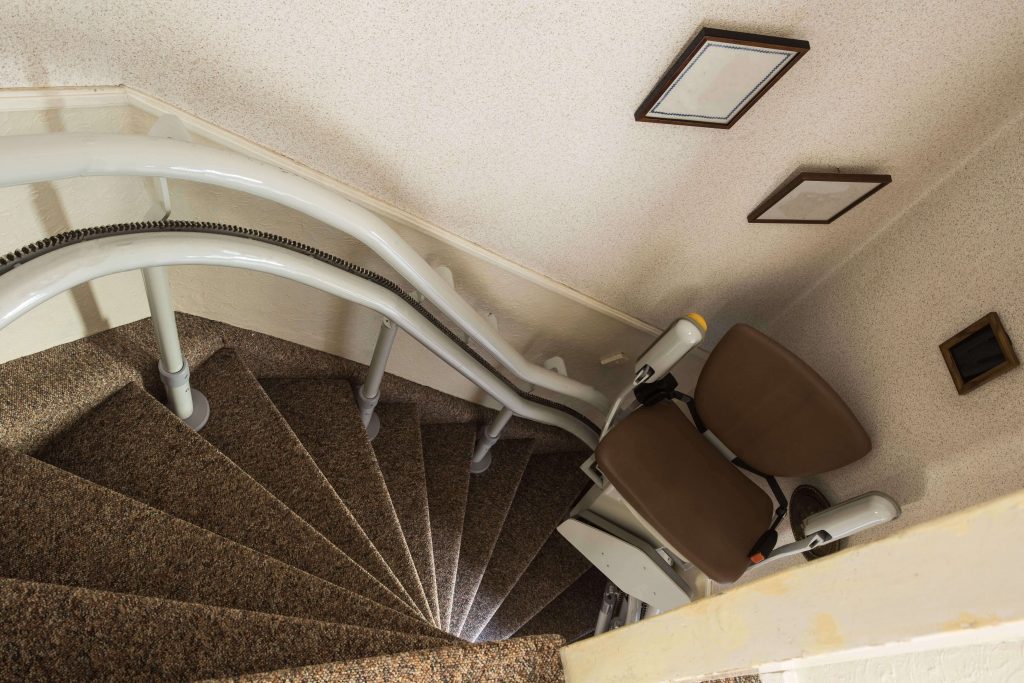Buying a Stairlift – what you need to know
Every home is different, and so is every person looking to purchase a stairlift. Stairlifts aren’t a one-size-fits all purchase, as different options are suitable for different types of users and their staircases. Here, we run through 5 of the things you need to think about before you commit to buying a stairlift.
1 – What type of stairs do you have?
It might seem obvious, but the first thing to think about when considering purchasing a stairlift is the type of stairs you have.
A completely straight set of stairs will of course be the simplest to cater to, but plenty of solutions now exist for stairs with corners, multiple landings, and even curved staircases.
If your stairs are particularly narrow or have a low ceiling, the manufacturer may want to know your height and leg length to ensure that you’re comfortable when using the stairlift and aren’t having to duck or sit in an uncomfortable position.
The general rule of thumb is that the more complex route the stairlift will have to take, the higher the cost will be. You’ll need to describe your stairs when calling a manufacturer, but don’t worry too much as most stores will send someone out to you to measure up before ordering a stairlift for you.
2 – What’s your budget?
As with any home adaptation, stairlifts don’t always come cheap. Before you even begin speaking to stairlift manufacturers, it’s a good idea to have a think about what sort of cost you can afford. Many manufacturers offer payment plans, which may allow you to spread the cost of your new stairlift.
Other options for reducing the cost of your stairlift purchase include buying a used or reconditioned stairlift, as well as seeing if there is any funding available from your local Council to help you.
Prices vary a lot, so we recommend trying at least three companies. Different manufacturers offer different ranges of stairlifts, too, so you may have to try more than one to find the lift that works best for you and your home.
3 – What kind of company would you like to deal with?
Some of us prefer to deal with larger companies, as we feel they may be more reputable or able to offer cheaper prices. However, many also prefer the often more personal service offered by smaller, local retailers.
There are two great ways to check that the company you’re choosing to deal with, whether big or small, is a reputable one that you can trust.
The British Healthcare Trades Association (BHTA) allows those who follow a specific code of practise and behaviour to become members. If the company you’re looking to deal with is a BHTA member, it’s usually a sign that they have committed to trading fairly.
You’ll want to ensure that the lift you’re buying meets safety standards. Any company that’s a member of the Lift and Escalator Industry Association (LEIA) has to adhere to the ISO 9001 standard and ensure that their products are made to the required standards.
It goes without saying that it’s wise to contact a few companies in order to get quotes, just to check that the price you’re being asked to pay is fair.

4 – What extras do you want on your stairlift?
There are a few added extras that come with certain stairlifts that could help to add that extra level of comfort or security.
Footrest raisers
When your stairlift isn’t in use, it can be folded upwards in order to minimise the amount of room it takes up. Most stairlifts have a footrest in order to make the journey up and down stairs more comfortable.
These footrests are quite low to the ground, but models with an automatic ‘footrest raiser’ can be purchased, meaning you don’t have to bend down when trying to fold the footrest away.
Swivelling seats
If you struggle to get out of your seat when reaching the top or bottom of the stairs, many stairlifts have the option of a swivel seat. You can turn the whole seat to the side, so you can step straight out onto the landing or into the hallway, rather than getting out of the seat sideways.
Easy-to-use controls
As well as your stairlift being comfortable to sit on, it also needs to be easy for you to control. Whether you’re left or right-handed, have limited ability to grip, or struggle pressing buttons,
You should be able to choose between right- and left-handed controls. They should offer other choices, including levers that are easy to use even if you have little grip or strength. Check that you’ll be able to easily hold the control in place for as long as it takes to get up or down the stairs. Some lifts have remote controls.
Lock
Locks can be especially important if you have any small, inquisitive humans living in or visiting your home! A lock can help ensure accidents don’t happen if there are children around that want to have a ride on the stairlift.
Hand-held remote controls and wall controls
What if you need to get up the stairs, but someone else has kindly used your stairlift and left it stranded at the top of the staircase? Many firms will now either fit controls to your wall that allow you to send your stairlift up or down the stairs without being sat in it or provide a remote control that does the same job.
5 – How are you going to care for your stairlift?
Remember, when you get a quote, it may not just include the initial cost of the stairlift but could include manufacturer’s warranty as well as a repair and service contract.
The majority of stairlifts, whether new or used, come with 1 year’s Manufacturer’s Warranty. This will cover you should your stairlift suffer an electrical or mechanical breakdown. Several companies, including Fish Insurance, offer extensions to this Manufacturer’s Warranty that can help to offer protection after this initial period has expired.

